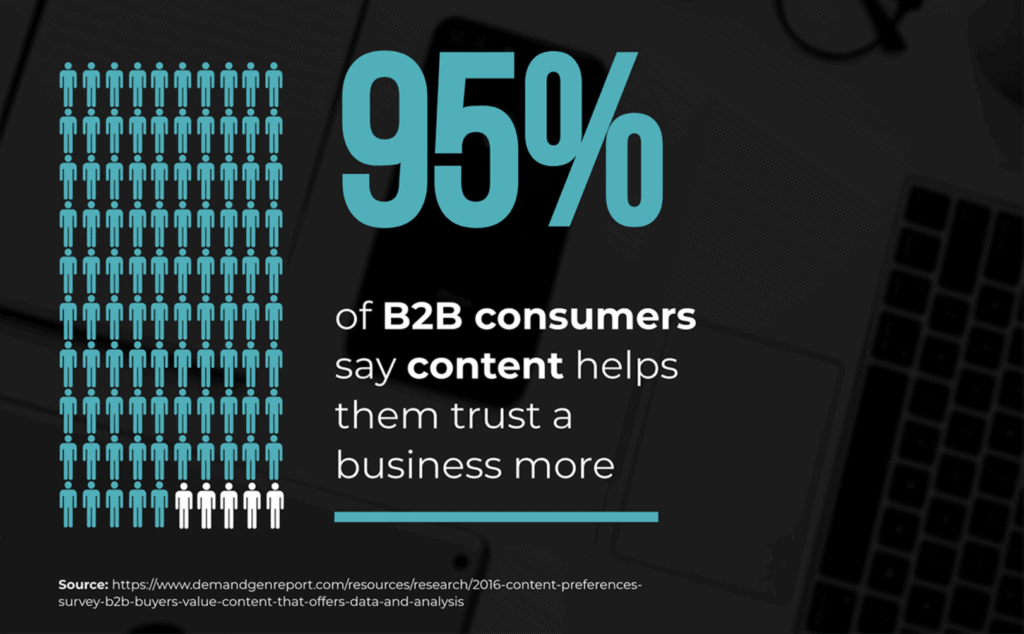Love it or hate it, content marketing is an absolute must-have for companies in the B2B space.
There are plenty of reasons this is true—content boosts your B2B SEO efforts and helps establish you as a trusted expert, for instance—but the number one reason content is critical has to do with the buyer journey.
Your buyers are likely more than 80% of the way through the B2B buyer journey before you even know they exist.
What that means is that they’re doing research on you for weeks or months (sometimes even years) before they ever interact directly with your brand.
They’re looking at your brand’s LinkedIn page to see what you post.
They’re searching for information on your industry or product type, and reading blog posts, guest posts, and articles—then sharing the good ones on their company Slack.
They’re watching video reviews and listening to podcasts.
And they’re almost certainly not searching for your brand by name. As Google reports, 71% of B2B researchers begin their research process through generic search, rather than branded search.
If you want them to find you—and not your competitors—then you’ve got to create consistent, high-value content that answers their questions and establishes your brand as the obvious choice.
This guide will show you how to do that.
You’ll learn:
- The many different types of content that comprise B2B content marketing (in other words, owned media)
- How to develop an effective B2B content marketing strategy
- Best practices for implementing your content marketing strategy
- How to measure your content marketing effectiveness
If you’ve been in digital marketing for more than a few minutes, you know that content marketing covers a huge range of formats and can help you meet many different goals.
In fact, you could argue that all digital marketing is content marketing—and to a degree, you’d be correct.
But for the purposes of this guide, we’ll be sticking to the “traditional” forms and functions of content marketing: content that your brand creates and distributes through a variety of channels in order to meet certain, specific goals.
Let’s get started.
What is content marketing?
Content marketing involves creating and sharing digital materials designed to deliver value to potential customers and inspire them to engage with your brand. It’s a form of inbound marketing, which draws customers to you. This is as opposed to outbound marketing, which puts your brand in front of potential customers through things like online ads, sponsored content, etc.
Content marketing has the added benefit of being highly cost-effective. In fact, content marketing costs 62% less than outbound marketing strategies and generates 3x the leads.
While we’re talking numbers, here are a few more content marketing statistics to know:
- 60% of the most successful B2B marketers have a documented content marketing strategy, reports the Content Marketing Institute.
- When it comes to content types, 69% of buyers prefer to learn about a product or service from a short video, while 18% prefer text-based formats like blog posts, websites, or articles. 4% of buyers prefer infographics, 3% prefer to download an ebook or report, 3% prefer webinars, and 2% prefer to receive a sales call or demo, reports Wyzowl.
- 79% of people bought a product or downloaded an app or software from a brand after seeing a YouTube video about it (also from Wyzowl).
- 70% of people would rather read a blog post about a product than learn about it from a traditional advertisement, according to Demand Metric.
B2B content marketing is specifically designed not to be overly promotional, but to be useful, interesting, educational, and/or entertaining.
It comes in many formats, including:
- Blog posts
- Articles
- E-books
- Reports and whitepapers
- Webinars
- Live streams
- Video content
- Podcasts
- Social audio
- Visual content (infographics, image galleries)
- Social media posts
- Slideshares
- Online courses
- Interactive content (quizzes, maps, charts)
Why spend all this time and effort creating content? Content marketing helps businesses increase their website traffic, grow brand awareness, generate new leads, and so much more. Even a single blog post can reap enormous benefits for your company. Here are just a few.
- Increases the number of pages on your website for Google to “crawl,” thereby increasing your chances of showing up on the first page of Google results for a given search term
- Can offer potential customers information they need for whatever stage of the buying process they’re in
- Increases the chance that other sites will link back to your site, as others can cite your blog post in their own content

Content marketing is one of the most effective ways to build your brand and define your voice. Customers want to know you’re credible. Credibility and content go hand in hand.
Now that you know what content marketing is, let’s move on to creating a content marketing strategy.
How to Develop an Effective B2B Content Marketing Strategy
The reason you need a strategy is simple: it’s much harder to execute effectively if you don’t have a written strategy. Here’s how to start.
The first step in developing your content strategy is to know your audience.
Whom are you trying to reach?
This is where buyer personas (or audience personas) come in.
Essentially, a buyer persona is a hypothetical individual with a name, picture, job title, income, interests, and pain points who acts as a stand-in for one group that you want to reach.
That could be, for example, CEOs of mid-market companies. Or marketing managers at Fortune 500 companies.
Crafting a buyer persona for each audience type you’re going after will help you better visualize the different types of people you’re crafting content for, and what types of content they like.
But you can go a step further when it comes to knowing who your audience is. In addition to the first-party data that you gather on your website visitors, from click behavior to things like names and emails in exchange for gated content, you can also gather zero-party data.

What is zero-party data, and how do you get it?
Zero-party data, a term coined by Forrester, is information that customers proactively, intentionally share with your brand. From purchase preferences, to email preferences, to personal information, anything that a customer gives you directly is highly valuable information—after all, you’re getting it directly from the source.
But since customers aren’t going to email you with a list of information about themselves, you do still have to offer ways for them to share it with you.
These can include:
- Mobile micro-experiences—if you have an app, gives customers the opportunity to answer 2-3 questions about their purchase intent, needs, etc. when they open the app.
- Emailed surveys (consider including a gift or prize for everyone who completes one)
- Pop-ups requesting job title and email, or other information
- Asking customers for their birthday in exchange for a gift, coupon, or discount on their special day
- Developing a communications preference center, which allows customers to choose how frequently they want to hear from you, which topics interest them, and more.
Once you understand your audience, the next step is to start brainstorming content for each audience type, and for each step in the B2B buyer journey.
To do this, you need to focus on pain points and needs. Go back to your buyer personas: what are the pain points you listed for each? What are their needs and desires?
If a pain point is something like, “needs to justify spend on services to CEO,” then you might plan a blog post called “Three key metrics to get your CEO to sign off on your budget.” You could create a video explaining how to get support for your budget from your COO (something we at Zen actually did). You could develop an infographic breaking down ways to estimate or report ROI from the B2B services your business uses.
Or you could do all these things, depending on your bandwidth.
If you’ve got several different audiences, this process will take longer, but you don’t have to lay out your content strategy for everyone all at once. Start by brainstorming a few pieces of content for each audience—then get to work executing.
As you begin to develop your collection of content, continue brainstorming and executing. If you plan well—in other words, if you’re executing content for each audience regularly, rather than focusing on only one—you’ll be in good shape.
Finally, make sure you’re thinking about the B2B buyer journey as you go. Lots of brands make the mistake of focusing on the awareness stage too much, and developing content for the top of the sales funnel.
However, you want to also develop content to help customers in the decision phase—these users will need content that’s geared toward more specific, granular topics.
And how about customers who’ve already purchased from you, and whom you want to retain? Content for these customers might include purchase surveys, or thank you emails, or testimonials from happy repeat customers.
Now for the hard part: how do you come up with great content on a consistent basis?
Developing B2B content ideas
Coming up with a consistent, ongoing stream of valuable content topics is where many content marketers get stuck—whether they’re B2C or B2B.
A good starting point is to see what kind of topics people in your industry are talking about on social media. One tool that Zen Media has been using for years is BuzzSumo. BuzzSumo shows you which posts on a given topic are the most shared, so you can see what topics and what types of posts are performing well.
Once you’ve come up with a list of topics you want to cover, you can test out those topics before generating an entire post or e-book or whitepaper about them.
One way to do this, according to Wordstream, is through Twitter. Send out a tweet linking to a case study, or an infographic, or simply offering a succinct piece of advice or wisdom. If the tweet does well among your followers, you might just be looking at a golden topic.
Then you can invest the time and energy into developing that topic into a full blog post, video, or e-book, with the knowledge that your audience will actually be interested.
Struggling to figure out your audience’s pain points? They typically fall into one of these four categories:
- Financial: Prospects/customers need to reduce the amount of money they’re spending on their current product or service
- Productivity: Prospects/customers are spending too much time using a product or service, and want something more efficient
- Process: Prospects/customers want to streamline internal processes or improve business systems (this is important mainly for B2B)
- Support: Prospects/customers need better support at one or more stages of the buying process
Let’s look at an example.
Say your brand offers an HR tech solution, and many of your current customers found you because they needed a streamlined way to manage hiring and payroll (a process pain point).
You would then start developing blog posts or videos around that topic. You’ll also want to include keyword research in your headline development process, so you ensure that you’re using keywords that will actually bring people to your site.
Keyword research is the bread and butter of content marketing.
It’s how we figure out which topics are trending, timeless, or to be avoided.
Look at the actual words and phrases people are using when they search for information on the web. You can find this out with Google Keyword Planner.
Then, you can see what keywords customers are searching that lead them to your site using a tool like Google Analytics.
By leaning on these keywords, you can create content that will show up on search results.
When you’ve done that, potential headlines could be things like:
- Three Signs Your Payroll Provider Is Wasting Your Time
- Five Benefits of Cutting-Edge Hiring Software
- Seven Ways HR Software Can Reduce Your Onboarding Timelines
Focus on solving the customer’s problems, while emphasizing your strengths, and the results will follow.
While you want your content topics to be relevant and timely, you also need a bank of evergreen content. Evergreen content is content that is not time-sensitive and continues to be relevant long past its publication.
This type of content is valuable because it can be shared and built on again and again. You can get lots of mileage out of this type of content because once you create it, it can continue working for you indefinitely.
One of Zen’s most effective pieces of evergreen content is a blog post answering 60 frequently asked questions about digital marketing. We first posted it back in 2014, and update it regularly as information changes. Throughout the past seven years, however, it’s continued to bring people to our site.
The best evergreen content is often in the form of listicles (like that blog post), tips, and how-to content, both written and visual (like videos and infographics). Remember to choose the right keywords, optimize for SEO, and use simple and clear language.
After that, it’s a matter of distributing your content effectively—more on that later.
How to Implement Your Content Marketing Strategy
When we’re talking about implementation, that involves a few different pieces:
- Getting your content written/created
- Distributing your content
- Amplifying your content
Getting your content written/created
Once you’ve developed your content calendar and strategy, it’s time to start creating your content.
You can either use your in-house team or outsource it to freelancers or a B2B marketing and PR company.
Both methods have pros and cons that are detailed more thoroughly in the above-linked post.
In brief, however, hiring freelancers or an agency can save your in-house team lots of time, especially if you want to get a lot of content ready in a short period of time.
On the flip side, it may take the freelancer or agency longer to get completely comfortable with your brand voice, to understand the technical details of your product or service, and acclimate, in general, to the way you want to represent your brand.
Regardless of whether you choose to keep content marketing in-house or outsource it, there will be an initial learning curve for everyone.
Distributing your content
Once you’ve got some content ready to go, how do you know where to distribute it?
One easy first step: stick it on your website. If you have a blog or resources section, you can add it there no matter what format the content is in.
When it comes to sharing via social, a good rule of thumb is to focus the greatest amount of effort on the channel that gets you the greatest results. In other words, if LinkedIn regularly gets you high-quality leads, optimize your content for LinkedIn first, before you focus on sharing it elsewhere.
Alternatively, if Instagram is where your posts get the most engagement, you’ll need to create a compelling visual component, and include the link to the full content in your bio.
Once you’ve optimized your content for your high-performing channels, you can go back and share it on your lower-priority channels.
Amplifying your content
Amplifying your content means getting the most possible attention on each piece possible. It means building on any positive press or momentum with your own efforts, both organic and paid.
Here’s an example. If your B2B brand gets some great press coverage, the first thing you’d want to do is share it widely, across all your media channels.
Then perhaps you’d create a blog post around the topic that was covered in that press, and share that.
You could create a video version of that blog post, linking back to that original press coverage, and post it on your YouTube channel as well as your blog, and perhaps share it in your newsletter.
Finally, you could also create paid ads that mention the great press you got in the copy, and then bring people to your website via a link to that blog post or video.
That’s amplification.
P.S. Here’s a secret: amplification is critically important when it comes to building an online reputation for your B2B brand. However, a lot of agencies, B2B PR agencies especially, overlook this.
How to measure the effectiveness of your B2B content marketing
While precisely quantifying the ROI of a particular piece of content is challenging, it is absolutely possible to know how effective your content marketing is at bringing in leads, growing awareness, and in some cases, converting a prospect to a customer.
The first step in figuring this out is to know which KPIs you should be tracking. Your brand may have additional metrics that are important, but here are a few good ones to start with.

Geographic Location
Understanding where your users are located helps you understand your audience and their needs, as well as allows you to create content built for specific cities, countries, or regions. If you have this information you can allocate your resources more effectively and accurately. Google Analytics provides in-depth details of such geographic information on every page, which enables the marketers to optimize the content and landing pages for those locations.
Unique Visits
Unique visits is the most standard and widely used measure for tracking individual views of content. This will help you identify which pieces of content are performing the highest, so you can create more like it.
Time Spent on Page and Bounce Rates
Bounce rates are relative, of course, but an average bounce rate for a page is between 41 and 55%.
If your bounce rate is higher than 60%, then you have some work to do. This is a sign that users aren’t getting what they want or expect from your content when they click on it. To fix this, try:
- Making sure your content fulfills the promise made in the headline or title
- Creating punchier intros that outline exactly what the user will get in the content
- Adding more visual content
- Ensuring your social posts tell users exactly what you’re linking to
If it’s lower than that 40%, then keep doing what you’re doing—and keep making it better!
Related to bounce rate is the time spent on the page—how long someone stays on your page before leaving. This will tell you whether people are actually reading or watching your content when they click onto it (although YouTube has its own analytics for things like watch time that you should keep a close eye on).
For example, 20,000 unique visits to a 5-page whitepaper, with an average time spent of 12 seconds, indicates a failure to engage the reader.
Click Patterns and Heat Maps
Tools like CrazyEgg allow the user to create heat maps to see the sections of a page getting the most attention. Google Analytics also offers in-page analytics to track click patterns. This can help you optimize your design, to make sure people are able to easily locate your content (which can have an effect on unique visits and bounce rates).
Page Views
Another basic but useful marketing KPI that is often overlooked has a direct correlation with the unique visits. A decent number of page views along with high unique visits signifies a healthy audience engagement. These two KPIs, when used together, can tell you if your viewers are coming back regularly for your content and whether a certain type of consumer loyalty is being established.
Social Shares and Comments
A user sharing your content is a good indication that they found that content useful or interesting, so a high number of shares is something to celebrate. At the same time, users may share content without even clicking on it, so if the shares aren’t reflected in a similarly high number of website visits or conversions, you still need to reevaluate your content.
Finally, rather than likes—which are hidden on Instagram now, anyway—take a look at your comments. Are users taking the time to comment on your post? And are those comments something substantial, rather than “nice” or a single emoji? You want your content to be attractive enough to stop the scrolling and inspire your followers to interact with you. Real, substantive comments are a good indicator that you’re successfully doing this.
Case Studies: What Can Content Marketing Do for Your B2B Brand?
Let’s close out with a couple of case studies, so you can see what content marketing looks like in real life.
Case Study #1: The American Association of Aesthetic Medicine and Surgery
The Challenge
Since 2006, The American Association of Aesthetic Medicine and Surgery (AAAMS) has trained physicians, registered nurses and practitioners in the art of aesthetics and non-invasive cosmetic surgery through hands-on workshops and conferences. When COVID-19 put a halt to in-person learning, AAAMS had to quickly pivot to an all-digital model, while maintaining efficacy and desirability for their aesthetic courses.
The Strategy
Zen devised a holistic digital marketing strategy designed to both expand and deepen AAAMS’ visibility across platforms. We developed and launched a brand-new website, focusing copy around the keywords that were most critical in pushing them to the top of Google’s results for organic search.
We also launched a multi-platform social media campaign that included daily posts, along with an ongoing email marketing campaign and twice-weekly informative, SEO-friendly blog posts. Finally, we launched a first-of-its-kind social platform for the aesthetic practitioner community, the AAAMS Aesthetics Network, promoting it with paid ads and email marketing.
The Results
- Increased income from online digital courses 41% over 6-month period, YOY
- 156% increase in course registration in the single month after launching the AAAMS Aesthetics Network, the only organization in North America for aesthetics professionals to meet, collaborate, and learn from each other
- Hit their first 6-digit revenue month since 2006
- Doubled sales in one month
Takeaway: Make SEO an integral element of your content marketing strategy, and integrate your email campaigns with social and blogging.
The Challenge
When COVID-19 put restaurants at risk of closing their doors for good and governmental guidelines begin to emerge dictating the terms of doing business in the “new normal,” OneDine was faced with an unprecedented opportunity: seize the moment as an innovative industry leader with high-tech solutions for helping restaurants overcome disruption, increase resilience, and fortify for the future.
The Strategy
Zen led an internal strategy-pivot designed to demonstrate OneDine’s deep solidarity with an industry in crisis: shift from sales-focus to support-focus that put OneDine’s contactless order and payment solutions in the hands of thousands of restaurant brands and food service businesses, for FREE.
We built momentum for OneDine’s moment with targeted, customized campaigns deployed across select social channels and media outlets that showcased the brand as an innovative industry leader and premier provider of solutions for the pandemic and rapidly approaching post-COVID world.
The Results
- Exponentially enhanced brand awareness with an aggressive PR campaign, including 44 earned media placements garnering 196M in online readership, more than 321k video views, and almost 10k social shares — all in under 60 days.
- Over 1.3 Million video views on social channels
- Dramatically elevated lead generation with a remarkable boost in qualified prospects from 63 (pre-COVID-19) to 163 in less than seven weeks, representing an increase from 11k to 26k restaurant locations.
- An extraordinary spike in closed sales in this same period, with more than 50 accounts signed representing over 3,000 units when fully deployed.
Takeaway: Use content marketing to show how your brand is living its values—not just paying lip service to them. And crises can become unprecedented opportunities to show your brand’s true colors.
Related post: B2B Influencer Marketing: An Ultimate Guide Plus Case Studies
We hope this guide is helpful to you on your content marketing journey. If you need more help, get in touch. We’d love to see what we can help you accomplish.







